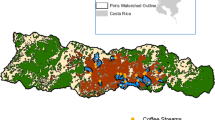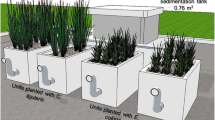Abstract
Although waste from coffee processing is a valuable resource to make biogas, compost, and nutrient-rich animal food, it is usually dumped into nearby water courses. We carried out water quality assessment at 44 sampling sites along 18 rivers that receive untreated waste from 23 coffee pulping and processing plants in Jimma Zone, Ethiopia. Twenty upstream sampling sites free from coffee waste impact served as control, and 24 downstream sampling sites affected by coffee waste were selected for comparison. Physicochemical and biological results revealed a significant river water quality deterioration as a result of disposing untreated coffee waste into running water courses. During coffee-processing (wet) season, the highest organic load (1,900 mg/l), measured as biochemical oxygen demand, depleted dissolved oxygen (DO) to a level less than 0.01 mg/l, and thus curtailed nitrification. During off season, oxygen started to recuperate and augmented nitrification. The shift from significantly elevated organic load and reduced DO in the wet season to increased nitrate in the off season was found to be the determining factor for the difference in macroinvertebrate community structure as verified by ordination analysis. Macroinvertebrate diversity was significantly reduced in impacted sites during the wet season contrary to the off season. However, there was a significant difference in the ratio of sensitive to pollution-tolerant taxa in the off season, which remained depreciated in the longer term. This study highlights the urgency of research exploring on the feasibility of adopting appropriate pollution abatement technologies to implement ecologically sound coffee-processing systems in coffee-growing regions of Ethiopia.



Similar content being viewed by others
References
APHA. (2005). Standard methods for examination of water and wastewater (21st ed.). Washington: American Public Health Association, American Water Works Association and the Water and Environment Federationb.
Bartram, J., & Balance, R. (Eds.). (1996). Water quality monitoring: a practical guide to the design and implementation of freshwater quality studies and monitoring programs: published on behalf of UNEP and WHO (pp. 50–92). London: Spon Press.
Beyene, A., Addis, T., Kifle, D., Legesse, W., Kloos, H., & Triest, L. (2009a). Comparative study of diatoms and macroinvertebrates as indicators of severe water pollution: case study of the Kebena and Akaki rivers in Addis Ababa, Ethiopia. Ecological Indicators, 9, 381–392.
Beyene, A., Legesse, W., Triest, L., & Kloos, H. (2009b). Urban impact on ecological integrity of nearby rivers in developing countries: the Borkena River in highland Ethiopia. Journal Environment Monitoring Assessment, 153, 461–476.
Cairns, J. (1995). Chemical versus biological pollution monitoring. In B. C. Rana (Ed.), Pollution and biomonitoring (pp. 7–25). New Delhi: Tata McGraw Hill.
Chave, P. (2001). The EU water framework directive (pp. 75–97). UK: IWA Publishing.
Cox, B. A. (2003). A review of dissolved oxygen modeling techniques for lowland rivers. Science of the Total Environment, 314–316, 303–334.
Davies, A. (2001). The use and limits of various methods of sampling and interpretation of benthic macroinvertebrates. Journal of Limnology, 60(supp 1.1), 1–6.
Davis, W. S., & Simon, T. P. (Eds.). (1995). Biological assessment and criteria: tools for water resource planning and decision making (pp. 22–25). Boca Raton: Lewis Publishers.
Fore, L. S., Karr, J. R., & Wisseman, R. W. (1996). Assessing invertebrate responses to human activities: evaluating alternative approaches. Journal of the North American Benthological Society, 15, 212–231.
Fournier, F. (1960). Climat et erosion; la relation entre l'erosion du sol par l'eau et les precipitations atmospheriques (1st ed., pp. 1–201). Paris: Presses Universitaires de France. In French.
Gemechu, D. (1977). Aspects of climate and water budget in Ethiopia (pp. 1–71). Addis Ababa: Addis Ababa University Press.
Haddis, A., & Devi, R. (2008). Effect of effluent generated from coffee processing plant on the water bodies and human health in its vicinity. Journal of Hazardous Materials, 152, 259–262.
Hornig, C. E., Pollard, J. E., (1978). Macroinvertebrate sampling techniques for streams in semi-arid regions: comparison of the Surber method and unit-effort traveling kick method. US EPA, EPA 600/4-78-040, pp. 1–21.
Jongman, R. H. G., ter Braak, C. J. F., & van Tongeren, O. F. R. (Eds.). (1995). Ordination data analysis in community and landscape ecology (pp. 91–173). UK: Cambridge University Press.
Joshi, H. C., & Sukumaran, P. K. (1991). Water pollution investigation in the River Tungabhadra near Harikar. Karnataka Indian Journal Animal Science, 61, 230–234.
Kondamudi, N., Mohapatra, S. K., & Misra, M. (2008). Spent coffee grounds as a versatile source of green energy. Journal of Agricultural and Food Chemistry, 56, 11757–11760.
Lehman, P. W., Sevier, J., Giulianotti, J., & Johnson, M. (2004). Sources of oxygen demand in the lower San Joaquin River, California. Estuaries, 27, 405–418.
López-Gómez, A. M., Williams-Linera, G., & Manson, R. H. (2008). Tree species diversity and vegetation structure in shade coffee farms in Veracruz. Mexico Agricultural Ecosyst Environment, 124, 160–172.
Mburu, J. K., & Mwaura, P. K. (1996). Environmentally sound management of coffee processing by-products: a review. Kenya Coffee, 61, 2237–2244.
Mburu, J. K., Thuo, J. T., & Marder, R. C. (1994). The characterization of coffee waste water from coffee processing factories in Kenya. Kenya Coffee, 59, 1756–1763.
Mwaura, P. K., & Mburu, J. K. (1998). Effect of wet processing of coffee on river water quality. Kenya Coffee, 63, 2779–2787.
Ostermiller, J. D., & Hawkins, C. P. (2003). Effects of sampling error on bioassessments of stream ecosystems: application to RIVPACS-type models. Journal of the North American Benthological Society, 23, 363–382.
Perfecto, I., Rice, R. A., Greenberg, R., & Van der Voort, E. (1996). Shade coffee: a disappearing refuge for biodiversity. BioScience, 46, 598–608.
Petit, N. (2007). Ethiopia's coffee sector: a bitter or better future? Journal Agrarian Change, 7, 225–263.
Schmitt, C. B. (2006). Montane rainforest with wild Coffea arabica in the Bonga region (SW Ethiopia): plant diversity, wild coffee management and implication for conservation. Ecology and Development Series, No. 47 (pp. 1–161). Göttingen: Cuvillier Verlag.
ter Braak, C. J. F., & Smilauer, P. (2002). CANOCO reference manual and CanocoDraw for windows user's guide: software for canonical community ordination (version 4.5) (pp. 1–500). Ithaca: Microcomputer Power.
ter Braak, C. J. F., & Verdonschot, P. F. M. (1995). Canonical correspondence analysis and related multivariate methods in aquatic ecology. Aquatic Science, 57, 256–288.
US-EPA. (1986). Quality criteria for water. Washington: U.S. Environmental Protection Agency (440/5-86-001).
Acknowledgements
We are very grateful for Addis Ababa University, Jimma Agricultural Research Center, and Jimma University, Ethiopia and International Foundation for Science (IFS), Sweden for their financial and logistic support. We are also thankful to Mr. Tesfu Kebede, Tadesse Eshetu, Amana Jemal, and Daniel Sahle for their assistance during the field work and laboratory analysis. The research of Abebe Beyene was supported with a grant from the OWS (VUB).
Author information
Authors and Affiliations
Corresponding author
Additional information
Abebe Beyene and Yared Kassahun are authors who contributed equally for this work.
Rights and permissions
About this article
Cite this article
Beyene, A., Kassahun, Y., Addis, T. et al. The impact of traditional coffee processing on river water quality in Ethiopia and the urgency of adopting sound environmental practices. Environ Monit Assess 184, 7053–7063 (2012). https://doi.org/10.1007/s10661-011-2479-7
Received:
Accepted:
Published:
Issue Date:
DOI: https://doi.org/10.1007/s10661-011-2479-7




